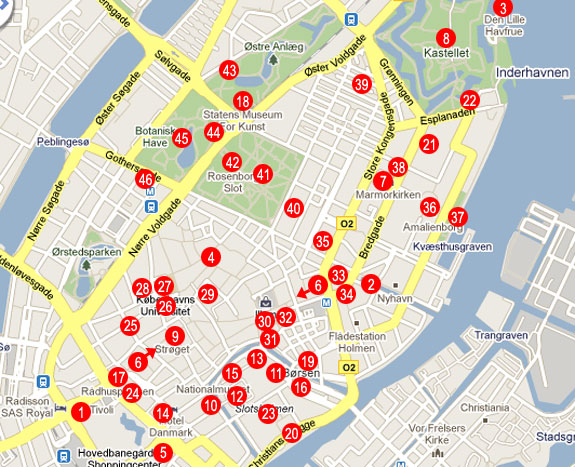Central Copenhagen - More Tourist Sites (København) - Part 4

25. The Piss Trench (Pisserenden). This region of Copenhagen was once a very seedy part of town. The area was riddled with brothels, crime, sleazy bars and all of the worst aspects of city life. The neighbourhood’s nickname ‘The Piss Trench (Pisserenden)’ comes from the bad smell of urine which used to permeate the area. There were so many drunks and homeless urinating on the walls and in stairwells that the entire area had a terrible stink of urine. Those days long gone and today the streets are full of many colourful shops, as well as many nice restaurants, bars, and cafés.
26. Chursh of Our Lady (Vor Frue Kirke). Copenhagen’s Vor Frue Kirke is a large church which was designed by the famous Danish architect C.F. Hansen. This is not the first church on the site. The church was built between 1811 and 1829 on top of the ruins of the old church. The previous church burned down the British attack on Copenhagen (København) in 1807. Inside the church there are impressive marble sculptures of Jesus and the 12 Apostles which were made by the world renowned Danish sculptor Bertel Thorvaldsen.
27. University of Copenhagen (Københavns Universitet). The University of Copenhagen was founded in 1479. The University is very well respected around the world and a substantial percentage of the student body comes from foreign countries. In 2007 Københavns Universitet was ranked as being the 8th best in Europe. The main University building was designed by the architect Peter Malling, and it was built in 1836. The northern Italian style building along the street ‘Fiolstræde’ holds the University’s library. The library building is not the original; this building was built in 1861.
28. St. Petri Church (Skt. Petri Kirke). St. Petri Church is the oldest preserved church in Copenhagen. Many sections of the church are from the 15th century. The church is known as ‘the German Church’ because in 1585 King Frederik II gave possession of the church to the small but very influential German-speaking community living in Copenhagen at the time. Skt. Petri Kirke would be primarily used by the German community for the next 3 centuries. A highlight of St. Petri Church is the intricate grave chapel system.
29. Grey Brother’s Square (Gråbrødretorv). Gråbrødretorv is a very cosy square with an interesting water fountain which was made by the silversmith and sculpture Søren Georg Jensen in 1971. The name of the square comes from the monastery called Grey Brother Monastery (Gråbrødrekloster) which was here between 1238 and 1530. Visible traces of the ruins of the monastery can be seen in the basement of building number 11. Building number 11 is was once the monasteries prison, however today it is a very atmospheric restaurant.
30. Amager Square (Amagertorv). While Amager Square is not a very big square, however it has been lively hub of activity since the Middle Ages when it was used by fishermen to sell their catch. Amagertorv might be the best place in Copenhagen to do a little people watching. The square is approximately halfway down the pedestrian walking street (Strøget). In the middle of the square is the Stork Spring Water Fountain (Storkespringvandet) which was made by Edvard Petersen and Herman Vilhelm Bissen in 1894. The square is covered with granite stones in yellow, black, grey and pink colours.
31. High Bridge Square (Højbro Plads). High Bridge Square is the fortunate result of a fire which devastated the area in 1795. The Højbro Plads square is a stones throw away from Amager Square (Amagertorv). Prior to the fire the area was very crowded with buildings. After the fire is was decided that the area should remain an open space for the people. The result is the square you see today. From the square there is a nice view of Thorvaldsens Museum, Christiansborg Castle and Børsen all of which are on the island of Slotsholmen. The enormous statue of the Bishop Absalon dominates the square. The statue was designed by Martin Nyrop in 1902.
32. St. Nicolaj Church (Skt. Nikolaj Kirke). The tower of St. Nicolaj Church dates from 1591 while the rest of the building was erected in 1917 as a reconstruction of the original Middle Age church, which burned down in 1795. The prior church building which burned down was very influential during the Reformation in Denmark. It was here that the teachings of Martin Luther were first preached in 1521. Luther’s teachings were first preached in German by German preachers; however in 1529 Hans Tausen began preaching the teachings of Martin Luther in Danish. Tausen also preached in the former original Skt. Nicolaj Kirke church building. Today the new building is being used to display art exhibitions.
Central Copenhagen (København) - Tourist Attractions (Part 1)
Central Copenhagen (København) - More Tourist Attractions (Part 2)
Central Copenhagen (København) - Tourist Sites (Part 3)
Central Copenhagen (København) - More Tourist Sites (Part 4)
Central Copenhagen (København) - Things to See and Do (Part 5)
Central Copenhagen (København) - Things to See and Do (Part 6)
Central Copenhagen (København) - Main Page
See Also:
Christianshavn (Copenhagen)
Millstream and its Lakes (Mølleåen og dens Søer) (Copenhagen)
LastUpdate: 2016-10-10 11:19:12
